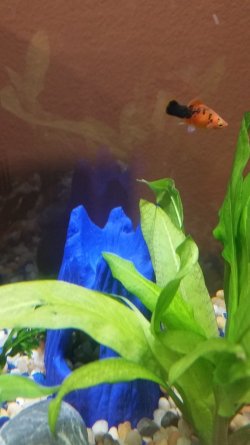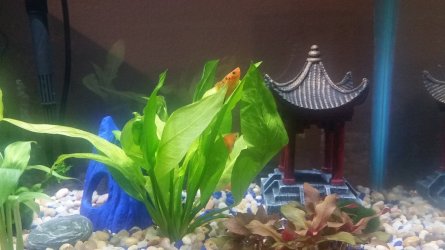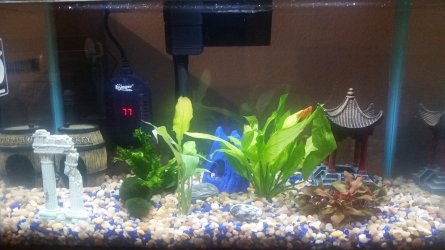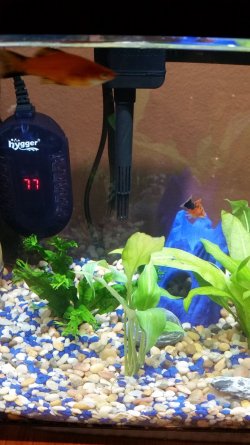That is the fish who was covered in white powder this morning after a salt bath. He has been shimmering all evening. It is scary.post new pictures of fish affected by fungus so we can confirm it is fungus.
the best treatment for livebearers (platies, swordtails, mollies, guppies) with fungal infections is salt.
You are using an out of date browser. It may not display this or other websites correctly.
You should upgrade or use an alternative browser.
You should upgrade or use an alternative browser.
Help. Platys stacked at bottom corner.
- Thread starter MetiSeifu
- Start date
It doesn't look like any fungus I've seen or experiencedThat is the fish who was covered in white powder this morning after a salt bath. He has been shimmering all evening. It is scary.
Assuming the unit is ppm, 75 ppm is far too soft for livebearers. This soft water will have weakened the fish to the point where they become very susceptible to disease and be unable to fight it off.gh 75
What do we do?Assuming the unit is ppm, 75 ppm is far too soft for livebearers. This soft water will have weakened the fish to the point where they become very susceptible to disease and be unable to fight it off.
It has clamped fins and excess mucous. It is either being stressed by poor water quality or has an external protozoan infection like Costia, Chilodonella, or Trichodina. All 3 protozoan infections can be treated with salt but the water needs to be checked too and it needs to be good.
Good aquarium water has 0 ammonia, 0 nitrite, less than 20ppm nitrate. The pH needs to be above 7.0 for livebearers, and the GH should be around 200ppm. Low GH is not causing this. This is caused by poor water quality or protozoans.
----------------------
You can add rock salt (often sold as aquarium salt), sea salt or swimming pool salt to the aquarium at the dose rate of 2 heaped tablespoon per 20 litres of water.
If you only have livebearers (guppies, platies, swordtails, mollies), goldfish or rainbowfish in the tank you can double that dose rate, so you would add 4 heaped tablespoons per 20 litres.
Keep the salt level like this for at least 2 weeks but no longer than 4 weeks otherwise kidney damage can occur. Kidney damage is more likely to occur in fish from soft water (tetras, Corydoras, angelfish, gouramis, loaches) that are exposed to high levels of salt for an extended period of time, and is not an issue with livebearers, rainbowfish or other salt tolerant species.
The salt will not affect the beneficial filter bacteria but the higher dose rate will affect some plants. The lower dose rate will not affect plants.
After you use salt and the fish have recovered, you do a 10% water change each day for a week using only fresh water that has been dechlorinated. Then do a 20% water change each day for a week. Then you can do bigger water changes after that. This dilutes the salt out of the tank slowly so it doesn't harm the fish.
If you do water changes while using salt, you need to treat the new water with salt before adding it to the tank. This will keep the salt level stable in the tank and minimise stress on the fish.
Good aquarium water has 0 ammonia, 0 nitrite, less than 20ppm nitrate. The pH needs to be above 7.0 for livebearers, and the GH should be around 200ppm. Low GH is not causing this. This is caused by poor water quality or protozoans.
----------------------
You can add rock salt (often sold as aquarium salt), sea salt or swimming pool salt to the aquarium at the dose rate of 2 heaped tablespoon per 20 litres of water.
If you only have livebearers (guppies, platies, swordtails, mollies), goldfish or rainbowfish in the tank you can double that dose rate, so you would add 4 heaped tablespoons per 20 litres.
Keep the salt level like this for at least 2 weeks but no longer than 4 weeks otherwise kidney damage can occur. Kidney damage is more likely to occur in fish from soft water (tetras, Corydoras, angelfish, gouramis, loaches) that are exposed to high levels of salt for an extended period of time, and is not an issue with livebearers, rainbowfish or other salt tolerant species.
The salt will not affect the beneficial filter bacteria but the higher dose rate will affect some plants. The lower dose rate will not affect plants.
After you use salt and the fish have recovered, you do a 10% water change each day for a week using only fresh water that has been dechlorinated. Then do a 20% water change each day for a week. Then you can do bigger water changes after that. This dilutes the salt out of the tank slowly so it doesn't harm the fish.
If you do water changes while using salt, you need to treat the new water with salt before adding it to the tank. This will keep the salt level stable in the tank and minimise stress on the fish.
Just to be clear, adding salt as Colin suggested is to kill any bugs on the fish, not to raise the GH.
I agree, the low GH won't be a direct cause of the infection, but it will stress the fish making it easier for them to catch an infection.
I agree, the low GH won't be a direct cause of the infection, but it will stress the fish making it easier for them to catch an infection.
Wow. Fish are not the easiest pets to keep, huh? I don't think even babies make you work as hard.
Once you grasp the issues, it is easy. You have very soft water, and you need to select soft water fish species. Livebearers will not live long in this water, regardless of any treatments for this or that. I can guarantee this.
The ammonia/nitrite indicates cycling as i suspected. That can be addressed with daily water changes until the bacteria are sufficient to deal with this. But the low GH/pH is still slowly killing the fish.
When livebearer species exhibit clamped fins, shimmying, excess mucus together it is almost always due to a lack of mineral in the water--the low GH/pH. Not always, but most often.
Two of our 5 platys [two of the three exhibiting illnesses] died yesterday. The third one won't probably last the weekend. We did everything in the book, changed water, cleaned tank, fed fish less, gave salt baths and used medications the internet suggested we do. Alas.
So, I was wondering:
1. Can certain types of platys be weaker in constitution than others? Two of the three that died are called, I believe, "Spotted". They are shorter in size, and given to seeking dark places, than the "Hallie/Halley" type that seem to be thriving. They were both also male. We believe the 5th fish that we introduced into the tank [a white/yellow? mickey mouse platy female] may have brought the disease, as things were not looking half as bad before she arrived. [We are also exploring ways on how to harden our water, per your suggestions]
2. Is it possible for illnesses to be passed into fishes of the same breed, and not to others?
3. Is insomnia a thing in fish? One of the two resilient species in our tank appears to always be up and swimming around every time we passed by the tank, even after the light is out. I tried wrapping the aquarium with a dark cloth, making sure all air entryways were open, a few days ago and she appeared fast asleep when I took it off in the morning. [She is usually still swimming around, despite no light and other fish being asleep, in the morning]
And is there anything we can do about it?
4. Is it generally unwise to keep an aquarium in the kitchen? We live on the 3rd floor of a wobbly apartment that threatens all things not nailed-down every time someone run up the stairs. And the kitchen island is the only thing that can support a 10 gallon tank in the whole place. Now, we are not cooking people. Twice a week, save for the occasional steaming of vegetables and popping [?] of pop-corns, is all we do. But I have been wondering if the smoke/steam/smell won't affect the fish badly, and contribute to a short life span.
4. If we decided not to get anymore fish, will the two surviving female platys be content?
Thank you for all your help on this journey. Please find here below a photo taken about a week ago. The two swimming in the picture are alive and well, the three fish lying at bottom of tank --- not so much. [Thought visual works better]
So, I was wondering:
1. Can certain types of platys be weaker in constitution than others? Two of the three that died are called, I believe, "Spotted". They are shorter in size, and given to seeking dark places, than the "Hallie/Halley" type that seem to be thriving. They were both also male. We believe the 5th fish that we introduced into the tank [a white/yellow? mickey mouse platy female] may have brought the disease, as things were not looking half as bad before she arrived. [We are also exploring ways on how to harden our water, per your suggestions]
2. Is it possible for illnesses to be passed into fishes of the same breed, and not to others?
3. Is insomnia a thing in fish? One of the two resilient species in our tank appears to always be up and swimming around every time we passed by the tank, even after the light is out. I tried wrapping the aquarium with a dark cloth, making sure all air entryways were open, a few days ago and she appeared fast asleep when I took it off in the morning. [She is usually still swimming around, despite no light and other fish being asleep, in the morning]
And is there anything we can do about it?
4. Is it generally unwise to keep an aquarium in the kitchen? We live on the 3rd floor of a wobbly apartment that threatens all things not nailed-down every time someone run up the stairs. And the kitchen island is the only thing that can support a 10 gallon tank in the whole place. Now, we are not cooking people. Twice a week, save for the occasional steaming of vegetables and popping [?] of pop-corns, is all we do. But I have been wondering if the smoke/steam/smell won't affect the fish badly, and contribute to a short life span.
4. If we decided not to get anymore fish, will the two surviving female platys be content?
Thank you for all your help on this journey. Please find here below a photo taken about a week ago. The two swimming in the picture are alive and well, the three fish lying at bottom of tank --- not so much. [Thought visual works better]
Attachments
Last edited:
Is that picture a new one or one from last week?
I ask because the water still looks cloudy and the fins are clamped. If it is an old picture, post a new one so I can see the water and fish that are left.
You mentioned giving salt baths. Did you add salt to the main tank or did you take the fish out and put them in a salt bath for a bit?
You should have added salt to their tank and left it in there.
1) All fish vary in their overall health and some fish have a stronger immune system than others. Fish with deformities (balloon fish, long finned fish, bubble eyes, etc) are generally not as strong as normal shaped fish due to the inbreeding. New colour varieties of fish are generally not as strong as older well developed colour strains.
2) Any fish can get sick but fish with a stronger immune system might not develop diseases when other fish in the tank do. However, it also depends on the disease. Some diseases will kill every fish in the tank if not treated.
3) All fish and animals have some variation when it comes to sleep patterns. Some fish will sleep longer than others. Some fish will stay up later than others. It can also be the fish in question has jet lag. Fish that have just been imported are still running on Asian time and it can take a few weeks for them to develop a new sleep pattern.
4) You can keep fish anywhere in the house as long as they aren't exposed to chemicals or fumes. Cooking with spicy foods can cause problems to fish but it is rare unless the food contacts the water somehow. Fumes from aerosols (hair spray, bug spray, air fresheners, etc) can cause problems but the fish usually gasp at the surface or act normally and die suddenly for no apparent reason.
5) If you don't get anymore fish the 2 remaining fish will be fine.
I would not advise getting any new fish until we work out what is going on currently.
I ask because the water still looks cloudy and the fins are clamped. If it is an old picture, post a new one so I can see the water and fish that are left.
You mentioned giving salt baths. Did you add salt to the main tank or did you take the fish out and put them in a salt bath for a bit?
You should have added salt to their tank and left it in there.
1) All fish vary in their overall health and some fish have a stronger immune system than others. Fish with deformities (balloon fish, long finned fish, bubble eyes, etc) are generally not as strong as normal shaped fish due to the inbreeding. New colour varieties of fish are generally not as strong as older well developed colour strains.
2) Any fish can get sick but fish with a stronger immune system might not develop diseases when other fish in the tank do. However, it also depends on the disease. Some diseases will kill every fish in the tank if not treated.
3) All fish and animals have some variation when it comes to sleep patterns. Some fish will sleep longer than others. Some fish will stay up later than others. It can also be the fish in question has jet lag. Fish that have just been imported are still running on Asian time and it can take a few weeks for them to develop a new sleep pattern.
4) You can keep fish anywhere in the house as long as they aren't exposed to chemicals or fumes. Cooking with spicy foods can cause problems to fish but it is rare unless the food contacts the water somehow. Fumes from aerosols (hair spray, bug spray, air fresheners, etc) can cause problems but the fish usually gasp at the surface or act normally and die suddenly for no apparent reason.
5) If you don't get anymore fish the 2 remaining fish will be fine.
I would not advise getting any new fish until we work out what is going on currently.
The fish on top is the one who I thought was going down hill last night. He is moderately active this morning. Eating, moving about, and not lying on the sand as much. The tank looks really clean to the naked eye, and we are always cleaning it. We also bought and installed adjustable heater this morning. There is just too much lighting in the kitchen that the tank looks blurry when photo is taken with a phone camera.Is that picture a new one or one from last week?
I ask because the water still looks cloudy and the fins are clamped. If it is an old picture, post a new one so I can see the water and fish that are left.
You mentioned giving salt baths. Did you add salt to the main tank or did you take the fish out and put them in a salt bath for a bit?
You should have added salt to their tank and left it in there.
1) All fish vary in their overall health and some fish have a stronger immune system than others. Fish with deformities (balloon fish, long finned fish, bubble eyes, etc) are generally not as strong as normal shaped fish due to the inbreeding. New colour varieties of fish are generally not as strong as older well developed colour strains.
2) Any fish can get sick but fish with a stronger immune system might not develop diseases when other fish in the tank do. However, it also depends on the disease. Some diseases will kill every fish in the tank if not treated.
3) All fish and animals have some variation when it comes to sleep patterns. Some fish will sleep longer than others. Some fish will stay up later than others. It can also be the fish in question has jet lag. Fish that have just been imported are still running on Asian time and it can take a few weeks for them to develop a new sleep pattern.
4) You can keep fish anywhere in the house as long as they aren't exposed to chemicals or fumes. Cooking with spicy foods can cause problems to fish but it is rare unless the food contacts the water somehow. Fumes from aerosols (hair spray, bug spray, air fresheners, etc) can cause problems but the fish usually gasp at the surface or act normally and die suddenly for no apparent reason.
5) If you don't get anymore fish the 2 remaining fish will be fine.
I would not advise getting any new fish until we work out what is going on currently.
Attachments
Last edited:
That is not very comforting.The two remaining platies will not live long, the water is too soft and it has weakened them and they cannot manage past that.
That is not very comforting.
No, the truth often is not comforting, but I see no value in misleading you into thinking that an improvement today is going to last. Livebearers cannot live in good health in soft water, it weakens their internal systems and they will succumb to this alone in time but often (as here) to other issues along the way. Individual fish, just like individuals in any animal including humans, can respond differently to detrimental illness/conditions but the damage is still there. I learned this by losing fish many years ago, as did many of us I'm sure.
I guess miracles DO happen because here below is our 3rd, and only, sick fish we did not expect to survive the weekend. He has been swimming with fins that are no longer clamped, eating/exploring and/or hanging out with the [healthier] females and not touching the sand with his stomach - not once! a few hrs after the new heater was installed. [He was clamped-finned, covered in whitish stuff, and not eating much - preferreing to sit on the bottom corner of tank - sometimes appearing to be gasping for breath].No, the truth often is not comforting, but I see no value in misleading you into thinking that an improvement today is going to last. Livebearers cannot live in good health in soft water, it weakens their internal systems and they will succumb to this alone in time but often (as here) to other issues along the way. Individual fish, just like individuals in any animal including humans, can respond differently to detrimental illness/conditions but the damage is still there. I learned this by losing fish many years ago, as did many of us I'm sure.
Oh happy days.
.

Attachments
Last edited:
Similar threads
- Replies
- 34
- Views
- 2K
- Replies
- 2
- Views
- 648
- Replies
- 10
- Views
- 513






